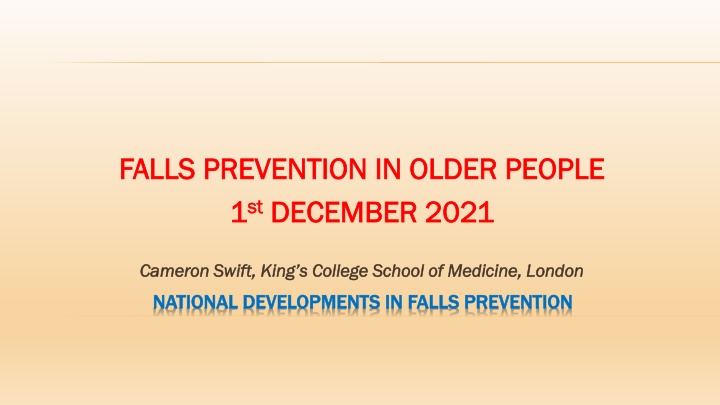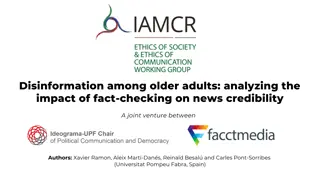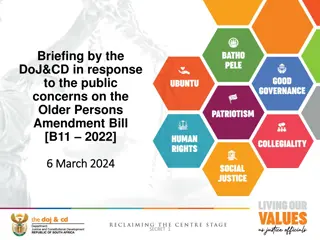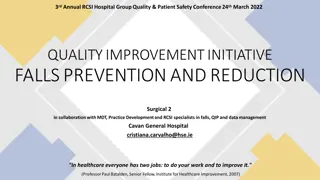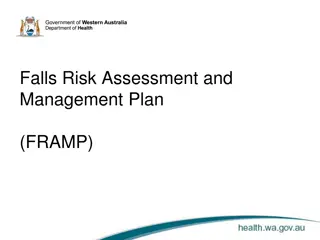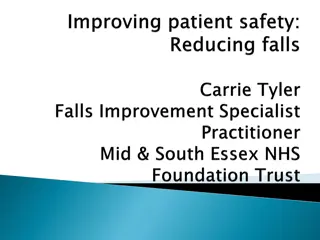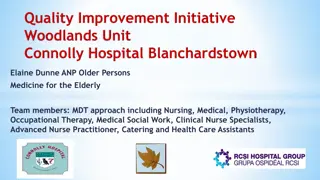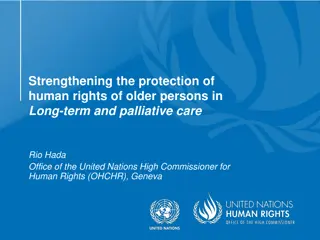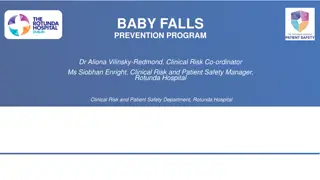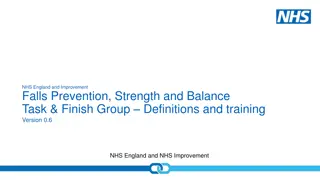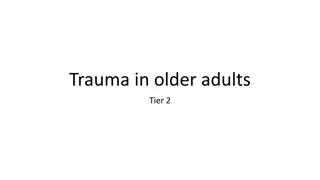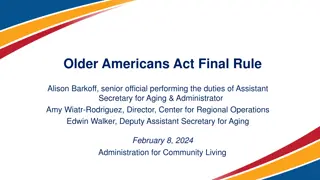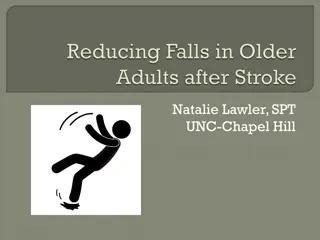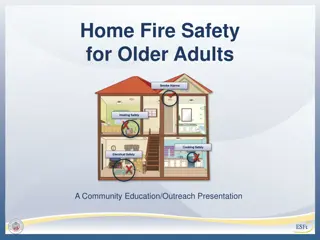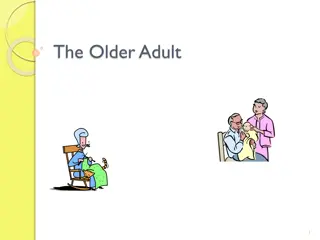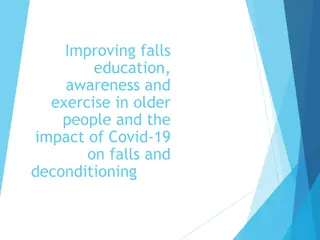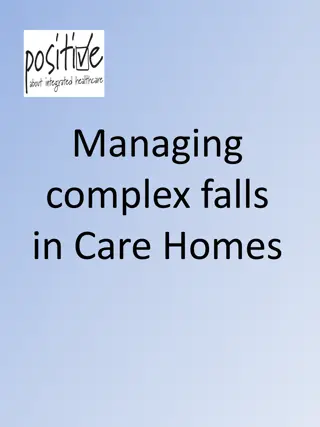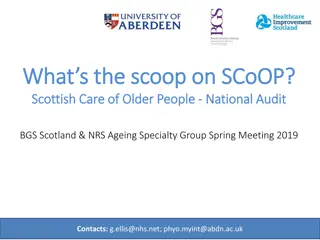Falls Prevention in Older People: Key Concepts and Strategies
Falls prevention in older people is crucial due to the high prevalence of falls in this age group, leading to injuries, disabilities, and increased healthcare costs. Key concepts include recognizing falls as a significant threat in later life and identifying intrinsic and extrinsic factors contributing to falls. Evidence shows that falls in later life are preventable through interventions targeting medical problems and improving physical fitness. Implementing effective falls services can help reduce the burden of falls in older individuals.
Download Presentation

Please find below an Image/Link to download the presentation.
The content on the website is provided AS IS for your information and personal use only. It may not be sold, licensed, or shared on other websites without obtaining consent from the author.If you encounter any issues during the download, it is possible that the publisher has removed the file from their server.
You are allowed to download the files provided on this website for personal or commercial use, subject to the condition that they are used lawfully. All files are the property of their respective owners.
The content on the website is provided AS IS for your information and personal use only. It may not be sold, licensed, or shared on other websites without obtaining consent from the author.
E N D
Presentation Transcript
FALLS PREVENTION IN OLDER PEOPLE FALLS PREVENTION IN OLDER PEOPLE 1 1st stDECEMBER 2021 DECEMBER 2021 Cameron Swift, King s College School of Medicine, London Cameron Swift, King s College School of Medicine, London NATIONAL DEVELOPMENTS IN FALLS PREVENTION NATIONAL DEVELOPMENTS IN FALLS PREVENTION
KEYS TO AN EFFECTIVE FALLS SERVICE KEYS TO AN EFFECTIVE FALLS SERVICE 1. Concept 1. Concept an age associated an age associated syndrome syndrome 2. Evidence 2. Evidence positive and negative positive and negative 3. Structure 3. Structure - - crossing all boundaries crossing all boundaries 4. Audit 4. Audit - - measuring process and measuring process and outcome outcome
(1) CONCEPT: FALLS IN LATER LIFE (1) CONCEPT: FALLS IN LATER LIFE A THREAT A THREAT 30% >65: 50%>80 fall at least 30% >65: 50%>80 fall at least once yearly once yearly Injury, disability, dependency, Injury, disability, dependency, mortality mortality NHS annual cost > 2.3bn NHS annual cost > 2.3bn
(1) CONCEPT: FALLS IN LATER LIFE: A SIGNAL (1) CONCEPT: FALLS IN LATER LIFE: A SIGNAL Commonly detectable (Intrinsic / Extrinsic): Commonly detectable (Intrinsic / Extrinsic): 1. 1. Ageing processes Ageing processes (diminished physiological reserve) (diminished physiological reserve) 2. 2. Suboptimal physical fitness Suboptimal physical fitness 3. 3. Stable specific impairment Stable specific impairment (e.g. sensory, motor, visual, CNS) 4. 4. Unstable systemic illness Unstable systemic illness (diagnosed or undiagnosed) 5. 5. Environmental risk factors Environmental risk factors (e.g. sensory, motor, visual, CNS) (diagnosed or undiagnosed)
(2) EVIDENCE (2) EVIDENCE - - POSITIVE: FALLS IN LATER LIFE POSITIVE: FALLS IN LATER LIFE PREVENTABLE (CLOSE ET AL, LANCET 1999) (CLOSE ET AL, LANCET 1999) PREVENTABLE 600 510 500 400 Control Intervention 300 203 183 156 151 200 73 60 50 100 0 0-4mth 4-8mth 8-12mth Total
(2) EVIDENCE (2) EVIDENCE - - POSITIVE : MEDICAL PROBLEMS IDENTIFIED - - (80% +) POSITIVE :- - EXAMPLES OF ATTRIBUTABLE EXAMPLES OF ATTRIBUTABLE MEDICAL PROBLEMS IDENTIFIED (80% +) (CLOSE ET AL, LANCET 1999) (CLOSE ET AL, LANCET 1999) Cardiovascular/circulatory Cardiovascular/circulatory (e.g. postural (e.g. postural hypotension , arrhythmias, hypotension , arrhythmias, carotid sinus syndrome, carotid sinus syndrome, pacemaker failure) (17%) pacemaker failure) (17%) Visual impairment (59%), Visual impairment (59%), poor stereoscopic vision poor stereoscopic vision (62%), cataract (35%) (62%), cataract (35%) Decreased lower limb Decreased lower limb power (28%) power (28%) Measured Measured strength/balance strength/balance impairment (72%) impairment (72%) Measured cognitive Measured cognitive impairment (34%), impairment (34%), depression (18%) depression (18%) Peripheral neuropathy Peripheral neuropathy (20%) (20%) Undiagnosed malignancy Undiagnosed malignancy (2%) (2%)
(2) EVIDENCE (2) EVIDENCE - - POSITIVE: FALLS IN LATER LIFE FALLS IN LATER LIFE PREVENTABLE POSITIVE: PREVENTABLE (LOGAN ET AL, BMJ 2010) (LOGAN ET AL, BMJ 2010) (7.68 vs 3.46 control vs intervention)
(2) EVIDENCE (2) EVIDENCE - - POSITIVE: FALLS IN LATER LIFE POSITIVE: FALLS IN LATER LIFE PREVENTABLE PREVENTABLE (DAVISON ET AL, 2005) (DAVISON ET AL, 2005) 700 600 500 Falls* Fallers (No) Fallers (%) Hospital Bed Days 400 300 200 100 0 Intervention (n=159) Control (n=154)
(2) EVIDENCE: BROADER OUTCOMES (2) EVIDENCE: BROADER OUTCOMES - - EFFECT OF AN A&E MULTIFACTORIAL INTERVENTION ON BARTHEL ADL INDEX MULTIFACTORIAL INTERVENTION ON BARTHEL ADL INDEX (FROM DATA OF CLOSE ET AL, 1999) EFFECT OF AN A&E- -BASED BASED 19.5 19 18.5 18 Control Intervention 17.5 17 16.5 16 Baseline 4 mth 8 mth 12 mth
(2) EVIDENCE (2) EVIDENCE - - EXERCISE IN OLDER PEOPLE LIVING IN THE COMMUNITY EXERCISE IN OLDER PEOPLE LIVING IN THE COMMUNITY (COCHRANE REVIEW 2019) REVIEW 2019) (SHERRINGTON ET AL) (SHERRINGTON ET AL) (COCHRANE 108 RCTs with 23,407 participants living in the community in 25 countries. 108 RCTs with 23,407 participants living in the community in 25 countries. Most trials had unclear or high risk of bias Most trials had unclear or high risk of bias 81 trials (19,684 participants) compared exercise (all types) with control 81 trials (19,684 participants) compared exercise (all types) with control Exercise reduces the rate of falls by 23% and number of people experiencing one or Exercise reduces the rate of falls by 23% and number of people experiencing one or more falls by 15% more falls by 15% Findings for other outcomes are less certain Findings for other outcomes are less certain
(2) EVIDENCE: FALLS IN INPATIENTS (2) EVIDENCE: FALLS IN INPATIENTS Heterogeneous studies Heterogeneous studies and settings (e.g. acute. and settings (e.g. acute. non non- -acute, mixed) acute, mixed) Highest risk category Highest risk category Inconsistent or negative Inconsistent or negative findings with single factor findings with single factor or non or non- -tailored tailored interventions interventions Risk factor prediction Risk factor prediction tools insufficiently tools insufficiently sensitive or specific sensitive or specific Some moderate/low Some moderate/low evidence for multifactorial evidence for multifactorial assessment and assessment and intervention strategies intervention strategies More research needed More research needed
(2) EVIDENCE (2) EVIDENCE - - POSITIVE: EFFECT OF TARGETED RISK FACTOR REDUCTIO POSITIVE: EFFECT OF TARGETED RISK FACTOR REDUCTION PROGRAMME ON INPATIENT FALLS PROGRAMME ON INPATIENT FALLS (PER THOUSAND OCCUPIED BED DAYS) (PER THOUSAND OCCUPIED BED DAYS) (HEALEY ET AL, 2004) N 25 20 15 Pre Post 10 5 0 Control Intervention
(2) EVIDENCE:NEGATIVE , UNCERTAIN OR (2) EVIDENCE: NEGATIVE , UNCERTAIN OR ATTENUATED INTERVENTION FINDINGS ATTENUATED INTERVENTION FINDINGS Single interventions Single interventions untargeted group exercise, cognitive/behavioural, untargeted group exercise, cognitive/behavioural, vision correction alone, Vit D (?) vision correction alone, Vit D (?) Focus on cognitive impairment (A&E /Care home) (e.g. Shaw et al, 2003, Focus on cognitive impairment (A&E /Care home) (e.g. Shaw et al, 2003, Whitney et al, 2017) Whitney et al, 2017) Unidisciplinary assessment with non Unidisciplinary assessment with non- -linked referral (Lightbody et al, 2002; linked referral (Lightbody et al, 2002; Spice et al 2009) Spice et al 2009) Risk factor prediction tools in inpatients [e.g. Barker et all (6 Risk factor prediction tools in inpatients [e.g. Barker et all (6- -Pack), 2015) Pack), 2015) Risk factor prospective postal screening intervention in primary care (Bruce et Risk factor prospective postal screening intervention in primary care (Bruce et al, 2021)( al, 2021)(PreFIT PreFIT) ) Assistive technology Assistive technology
THE 6 THE 6- -PACK (RISK PREDICTION TOOL BASED) STUDY PACK (RISK PREDICTION TOOL BASED) STUDY [BARKER BMJ BMJ (2016) 352; (2016) 352;h h6781] 6781] [BARKER et al et al; ;
P Pre reFIT FIT Cluster RCT Cluster RCT (Bruce et al, 2021) (Bruce et al, 2021)
(3) STRUCTURE: CG 161 GENERIC FALLS (3) STRUCTURE: CG 161 GENERIC FALLS ASSESSMENT AND INTERVENTION ACTIVITY ASSESSMENT AND INTERVENTION ACTIVITY (UK EVIDENCE & FOCUS) EVIDENCE & FOCUS) (UK CASE/RISK IDENTIFICATION NETWORKED FALLS SERVICE Case / risk identified at routine health screen INDIVIDUAL- ISED SINGLE OR MULTI- FACTORIAL INTERVEN- TION & FOLLOW-UP MULTI- FACTORIAL ASSESS- MENT PRIMARY & COMMUNITY CARE Case / risk identified at presentation with fall / other problem Case / risk identified at presentation with fall / other problem SECONDARY CARE Presentation at A&E with fall injury/ Inpatient >65 / or Inpatient >50 with known clinical risk BONE HEALTH SERVICE
(3) STRUCTURE (3) STRUCTURE - - COORDINATING ACROSS BOUNDARIES: COORDINATING ACROSS BOUNDARIES: GENERIC FALLS SERVICE NETWORK GENERIC FALLS SERVICE NETWORK AN OPPORTUNITY TO LEAD TO LEAD AN OPPORTUNITY PRIMARY & COMMUNITY CARE MAINSTREAM SECONDARY CARE ACCIDENT & EMERGENCY MEDICINE NETWORKED FALLS SERVICE (LINKED TO MEDICAL GERONTOLOGY) POPULA TION-BASED/ OPPORTUN- ISTIC SCREENING ACUTE INPATIENT MEDICAL GERONTOLOGY TRAUMA, & ORTHO- PAEDICS OTHER MEDICAL & SURGICAL SPECIALITIES DAY HOSPITAL, OUTPATIENT CLINICS & REHABILITATION HOME-BASED EXERCISE PROGRAMMES BONE HEALTH SERVICE
(3) STRUCTURE (3) STRUCTURE - - IMPROVING IMPLEMENTATION IMPROVING IMPLEMENTATION (RCP 2017) (RCP 2017) MANAGEMENT LEVEL MANAGEMENT LEVEL CLINICAL CLINICAL Organisation Organisation- -wide Patient Safety Group wide Patient Safety Group Structured rapid assessment procedures Structured rapid assessment procedures (including standardised delirium tools) (including standardised delirium tools) Robust data and reporting on falls & Robust data and reporting on falls & fractures fractures Multi Multi- -D Falls Working Group auditing v QS D Falls Working Group auditing v QS 86 86 Audit of Postural BP, Visual, Medication and Audit of Postural BP, Visual, Medication and Walking Walking- -aid use review and provision aid use review and provision
(4) AUDIT. (4) AUDIT. FALLSAFE FALLSAFE CARE BUNDLE KEY ELEMENTS CARE BUNDLE KEY ELEMENTS [RCP 2015] [RCP 2015] Cognitive assessment* Bed-rail/Ultra-low bed strategy* Delirium screen* Lying & standing blood pressure & pulse* Medical & medication review* Basic visual check* Tailored on-ward (v 2-hr) observation regimen
(4) AUDIT (4) AUDIT - - INPATIENT IMPLEMENTATION & OUTCOME MEASUREMENT INPATIENT IMPLEMENTATION & OUTCOME MEASUREMENT FALLSAFE QI EVALUATION QI EVALUATION [HEALEY ET AL 2014] [HEALEY ET AL 2014] FALLSAFE
4: LOCAL AUDIT/QI: INPATIENT FALLS PER 1,000 BED DAYS AT NORTHUMBRIA HEALTHCARE NHS FOUNDATION TRUST 2013 2020. (Richardson et al., 2020)
(4): NATIONAL AUDIT (4): NATIONAL AUDIT ( (i i) ) NICE GUIDANCE (CG161) NICE GUIDANCE (CG161) (update pending (update pending - - 2024) 2024) Case/risk identification Case/risk identification Multifactorial falls risk assessment/diagnosis Multifactorial falls risk assessment/diagnosis Falls history Falls history Assessment of: Assessment of: gait, balance and mobility, and muscle weakness gait, balance and mobility, and muscle weakness osteoporosis risk osteoporosis risk perceived functional ability and fear relating to falling perceived functional ability and fear relating to falling visual impairment visual impairment cognitive impairment and neurological examination cognitive impairment and neurological examination urinary continence urinary continence environmental hazards environmental hazards Cardiovascular examination and medication review Cardiovascular examination and medication review Individualised multifactorial interventions Individualised multifactorial interventions
(4) NATIONAL AUDIT (4) NATIONAL AUDIT ( (ii ii) NICE QUALITY STANDARD QS86 ) NICE QUALITY STANDARD QS86 (2017 UPDATE STATEMENTS) 1 Older people are asked about falls when they have routine assessments and 1 Older people are asked about falls when they have routine assessments and reviews with health and social care practitioners, and if they present at hospital. reviews with health and social care practitioners, and if they present at hospital. 2. Older people at risk of falling are offered a multifactorial falls risk assessment. 2. Older people at risk of falling are offered a multifactorial falls risk assessment. 3. Older people assessed as being at increased risk of falling have an individualised 3. Older people assessed as being at increased risk of falling have an individualised multifactorial intervention. multifactorial intervention. 4.Older people 4.Older people who fall during a hospital stay who fall during a hospital stay are checked for signs or symptoms of fracture and potential for spinal injury before they are moved. fracture and potential for spinal injury before they are moved. 5. Older people 5. Older people who fall during a hospital stay who fall during a hospital stay and have signs or symptoms of fracture or potential for spinal injury are moved using safe manual handling fracture or potential for spinal injury are moved using safe manual handling methods. methods. 6. Older people 6. Older people who fall during a hospital stay who fall during a hospital stay have a medical examination 7. Older people 7. Older people who present for medical attention because of a fall who present for medical attention because of a fall have a multifactorial falls risk assessment. multifactorial falls risk assessment. 8. Older people living in the community 8. Older people living in the community who have a known history of recurrent falls are referred for strength and balance training. are referred for strength and balance training. 9. Older people 9. Older people who are admitted to hospital after having a fall who are admitted to hospital after having a fall are offered a home hazard assessment and safety interventions. hazard assessment and safety interventions. (2017 UPDATE STATEMENTS) are checked for signs or symptoms of and have signs or symptoms of have a medical examination. . have a who have a known history of recurrent falls are offered a home
(4) NATIONAL AUDIT (iii) ( (NAIF NICE QS 86 ADHERENCE NICE QS 86 ADHERENCE NAIF) )(RCP 2020)
(4) NATIONAL AUDIT (4) NATIONAL AUDIT NAIF SNAPSHOT DATA NAIF SNAPSHOT DATA - - INPATIENT FALLS 2017 ( INPATIENT FALLS 2017 (v v 2015) (RCP 2019) 2015) (RCP 2019)
(4) 30-DAY HIP FRACTURE MORTALITY, 2011-2018 (NHFD 2019)
(4) NHFD 6 KPIS FOR INPATIENT & NON-INPATIENT HIP FRACTURE [NHFD 2021]
(4) NATIONAL AUDIT OF INPATIENT FALLS (NAIF) 2018-21 (RCP 2020) Focus on inpatient hip fracture (IHF). Rational sensitive audit outcome measure Continuous year-round national data collection (NHFD) Increased incentive for trust level participation Fall prevention management audited for IHF only All inpatient settings eligible to participate (inc. community, specialist, mental health trusts) Data collection to include immediate post fall management (QS 86) Data entered onto the NHFD as IHF Once yearly facilities audit
(4) NATIONAL AUDIT (iii) ( (NAIF NICE QS 86 ADHERENCE NICE QS 86 ADHERENCE NAIF) )(RCP 2020 - 2021)
(4) IMPLEMENTATION MANAGEMENT IMPLEMENTATION MANAGEMENT (NAIF FACILITIES AUDIT 2019 & 20) (RCP 2021)
NICE CG 161: COST NICE CG 161: COST- -EFFECTIVENESS OF INPATIENT FALLS PREVENTION EFFECTIVENESS OF INPATIENT FALLS PREVENTION
KEYS TO AN EFFECTIVE FALLS SERVICE KEYS TO AN EFFECTIVE FALLS SERVICE 1. Concept 1. Concept an age associated an age associated syndrome syndrome 2. Evidence 2. Evidence positive and negative positive and negative 3. Structure 3. Structure - - crossing all boundaries crossing all boundaries 4. Audit 4. Audit - - measuring process and measuring process and outcome outcome
